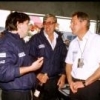I've recently started to doubt everything I thought I knew about setting up F1 cars in realistic sims like Gp4 or rFactor.
At the moment, I am retrying the 1991 historic F1 mod... and it got me baffled. I thoroughly enjoy it, I just can't get it to change behaviour. It basically understeers when you go off the brakes. I thought I understood rollbar vs bump settings, but apparently I don't...
I have a lot of experience in modding and setting up F1 cars in the virtual world. In Gp4, in historic mods like the 1980 and 1982 mod, I can set up the car exactly like I want. I know how to set fast and slow bumps, diffs, etc, etc, etc...
However, with the 1991 mod, for example on Interlagos, for example, I can't get the Tyrrel-car to steer into the corner after releasing the brakes. Neither can I with the Dallara or the Lotus.
I've tried softer springs, softer rollbars, I even set the front bump dampers to idiotic low levels compared to the rear, taken away all the diff lock, etc, etc. I've tried settting the steering lock to 30 percent.. which only results in exit oversteer after extreme entry understeer (it figures!). The car just doesn't want to steer in that corner directly after the straight. It responds to braking and steering... and after the brakes are released it seems the car just doesn't want to roll over to the front and to the left.
Ofcourse, if I set the rollbar really soft in the front, the car will respond... but then it will be undriveable in quick sweeps left and right.
Am I missing something?


















